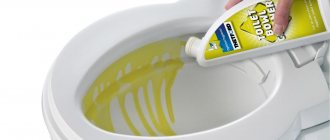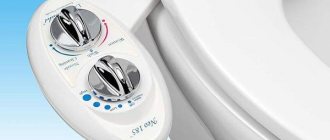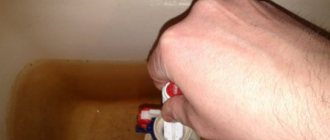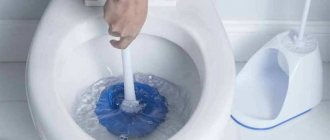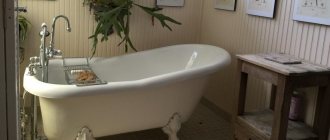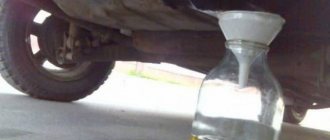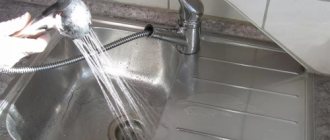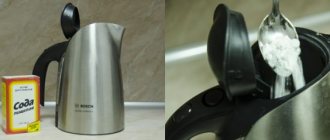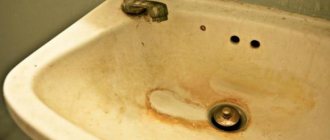Poor quality tap water, old metal or cast iron pipes can cause rusty deposits to begin to accumulate in the tank.
As a result, after some time, rusty water leaves a red coating on its walls, which is quite difficult to get rid of.
Keeping the inside of the toilet tank clean will help prevent such problems and will also extend the life of the flush mechanism.
We'll tell you in this article how to clean the inside of a toilet tank from rust.
Causes of clogged drain tank
It would seem that there is nowhere for dirt to come from a closed container. However, a dark coating sooner or later appears on the walls of the tank. This is due to the following reasons:
- Tap water is not perfectly clean. It almost always contains impurities of mineral salts and rust, which settle on the walls of the tank. The tank gets especially dirty on days when water pipes are being repaired in the house. After such repairs, very rusty water usually flows from the tap for some time. Naturally, the same water enters the tank, and dirt settles on the walls. Over time, the dirt petrifies, turning into a limescale build-up that is highly hard and difficult to remove.
- The lid on ceramic products fits quite tightly. However, sometimes it happens that it is not closed well, and then dust gets inside, which settles at the bottom of the tank and becomes a breeding ground for mold fungi.
- Lack of hygiene. In many homes, this container is not cleaned for years: they simply forget about it. If the product is not cleaned, sooner or later dirt will appear in it.
Plaque on the walls of the barrel or dirt on the bottom of the product shortens its service life. Water in such a tank begins to leak from under the valve. In addition, dirty water clogs the toilet itself, it quickly loses its whiteness and shine. In order for the hygiene room to be cozy and clean, it is necessary to systematically restore order.
Why does plaque appear inside the tank?
As it is used, a white or rusty coating appears inside the toilet cistern. In both cases, the formation of such contaminants is determined by the composition of the water. The liquid entering the drain tank contains metal impurities and dissolved calcium salts. Both substances, settling, form a coating of orange and white color, respectively, on the walls and bottom.
More often, light deposits appear in the toilet cistern. The appearance of orange marks is usually caused by faulty or outdated water pipes. As corrosion develops on the elements of the communication system, iron penetrates into the water, which enters the toilet. And the larger the rust on the pipes, the faster the orange coating forms.
Similar consequences result from the use of hard water containing large amounts of iron. And, if the reason for the formation of rusty deposits described above can be eliminated by replacing the pipes, then in the latter case you will have to install special filters.
How to properly clean the drain tank?
The first thing to do to clean the tank is to open it. Modern tanks are not so easy to open. The fact is that when you lift the lid, the drain button will be automatically pressed. To avoid problems, before cleaning the toilet tank from rust inside, you need to turn off the running water. Then you need to press the drain button to empty the container. As a rule, it is on this button that the lid itself is held on. To remove it, you just need to twist the cover together with the part that secures it counterclockwise. She'll take off.
To remove the lid from the toilet cistern, first remove the flush button
In plastic tanks, the part that holds the lid is usually attached to the side with screws or bolts. You need to unscrew it and remove the cover to the side.
Then you can start cleaning the drain tank. This can be done using store-bought household chemicals or at home.
Adviсe
A few recommendations from experienced housewives will help keep the cistern clean:
- Regular cleaning will save you from the painful process of removing old rust stains.
- Monitoring the condition of the plumbing system in the house will not only improve the quality of the water supplied, but also prevent the appearance of rusty deposits on the inner walls of the tank.
- Special anti-plaque and rust tablets placed inside the tank will protect surfaces from premature contamination.
If the first time it was not possible to achieve the desired cleanliness effect, then it is better to repeat the procedure again.
Under no circumstances should you mix several chemical compounds together or increase the time of exposure of the product to the walls of the tank. The result of such actions may be unpredictable.
You will find all the most important information about methods and means for cleaning a toilet from rust here.
Cleaning the drain tank with store-bought products
If the plumbing fixture has not been cleaned for a long time, the deposits on its walls and bottom will not be easy to remove. Therefore, to wash the tank in this case, it is recommended to use a store-bought product that is usually used to clean the toilet itself. Moreover, any housewife almost always has a “toilet duck” of any brand in her arsenal. The most common cleaning agents are:
- Sanox. This is a budget gel that can quite effectively remove limescale and rust from the walls of ceramic products. A bottle of Sanok gel costs only 330 rubles, and the result of use most often completely satisfies the housewives.
- Domestos. One of the most famous gels for cleaning toilets. It cannot be classified as cheap, but it has long won the trust of the most pedantic housewives, because it is really capable of a lot. True, it also has disadvantages: its composition is very aggressive and can harm sensitive people. If you still decide to take a risk, try to work with it as carefully as possible, put on a protective mask, open a window in the apartment so that the harmful fumes evaporate faster. A bottle of gel with a capacity of 500 ml costs about 600 rubles.
- Sanfor. This is a cheaper analogue of Domestos, which is impressive in its ability to dissolve limescale, urinary stone and rust. You can find several varieties of this product on sale: Sanfor anti-rust, universal, disinfection, etc. Each of them is designed to combat one or another contamination.
The product will help cope with contamination and disinfect surfaces.
- Sillit. This gel contains caustic acids, thanks to which it copes well with various contaminants. It will quickly clean the toilet tank of old plaque.
- Cinderella. This toilet gel removes unpleasant odors, plaque and rust. Quite an effective budget tool.
- Comet. A popular cleaning product that is highly effective. This product is praised by many experienced housewives.
- Cream Cif. It gently cleans the ceramic surface, while effectively removing dirt - limescale, rust, dust. The cream is applied to a sponge and the walls and bottom of the tank are polished with it. You can keep it on the surface for 10 to 30 minutes. Then rinse thoroughly with water.
Cinderella - a budget assistant in the fight for cleanliness
The popular Whitener with chlorine will effectively remove black deposits from ceramic surfaces. You just need to pour it into the tank, fill it with water and leave it for 4-5 hours, then drain it. Any of the listed means for cleaning the walls of the tank is used according to the same rules:
- First, using a hard sponge, the product is applied to the walls of the plumbing fixture. It is necessary to work with gloves. If a caustic chemical is used for cleaning, it is also a good idea to wear a special protective mask.
- After application, the product must be left on the surface for some time. If the contamination is severe, you can extend the time of contact with the cleansing gel to 12 hours, but this rule only applies to those substances that are gentle. For example, it is better to put citric acid in the tank overnight, but it is undesirable to leave chlorine-containing substances for the same period of time.
- After a certain time, the walls and bottom of the tank should be thoroughly rubbed with a sponge to remove any remaining dirt and deposits.
- After the described manipulations, you need to fill the tank with water and drain it several times.
After cleaning the plumbing, the toilet should be ventilated. This type of cleaning can be done once every 3-4 months.
A brush or stiff sponge can help remove heavy dirt.
Store-bought products are effective and easy to use. In addition to those listed above, you can use many other similar cleaners: modern manufacturers of household chemicals offer a wide selection of different substances. But if you don’t have such a gel at home and you can’t buy it at the moment, you can use home remedies. How to clean the inside of a toilet tank without a special product? Any housewife can find the answer to this question in her kitchen.
How to clean the fittings in the tank
To wash the fittings in the toilet cistern, it is recommended to use Belize or other similar cleaning agents.
You cannot use folk remedies in this case. This is explained by the fact that after such cleaning, it is necessary to treat the contaminated areas with a brush, which can damage fragile fittings.
To remove contaminants, you need to dismantle the internal elements and place them in the prepared Whiteness solution, leaving for 10–15 minutes. If necessary, this procedure will have to be repeated, increasing the time interval.
Homemade Cleaning Remedies
If the tank is not very dirty, a non-aggressive product will cope with the contamination. The following substances can be used as weapons:
- Table vinegar. This substance is not particularly caustic, but it is quite capable of coping with a small coating. You need to work with it the same way as with other cleaning agents: saturate a sponge with it and wipe the surfaces. Leave for half an hour, then rinse.
- Soda. It helps to wash away many types of contaminants and also removes traces of rust if it has not yet become deeply ingrained. The powder is applied to a sponge, which is then used to clean the inner walls of the tank. Soda will not remove heavy dirt, so leaving it on the surface for a long time does not make sense. The product is usually washed off immediately after cleaning the plumbing fixture.
- Oxalic acid. Pour the acid powder onto a cloth, rub it on the contaminated surface, leave for an hour, then rinse with water.
- Toothpaste. This popular and affordable product for cleaning the inside of the tank is found in every home. It is used in the same way as other household cleaners: applied to a sponge and cleaned the surface. After the manipulations, the paste is immediately washed off.
Cleaning should be done regularly, this will help preserve the tank mechanism
- Lemon acid. This simple remedy will work well even with petrified deposits on the walls of the tank. Using the product is easy. It is enough to take 2-3 bags of acid (100 g each), pour them into a tank filled with water, stir and leave for 4-5 hours, then drain the water. If possible, it is advisable to first fill the tank with hot water and pour acid into it. The effect of application is wonderful. If, after such an acidic procedure, traces of contamination remain on the walls, they can be washed off with a sponge and soda or cleaning powder for kitchen surfaces.
- Washing powder. It perfectly removes contaminants of various origins, if they have not yet become firmly ingrained. The product is applied to an ordinary sponge, used to clean the walls of the tank, and washed off immediately, otherwise the powder will dry out and you will have to scrub it off. After this method, the product will not only shine with cleanliness, but will also acquire a pleasant aroma.
Beautiful and Successful knows how to clean a clogged toilet >>
- Battery electrolyte. This substance contains aggressive acids, so the electrolyte easily and quickly removes black deposits and rust from surfaces. At home, this product for cleaning the inside of the toilet tank will help bring even very neglected plumbing fixtures into perfect condition. Cleaning is easy. It is necessary to pour the liquid into the tank and leave for an hour. Some sources recommend leaving the electrolyte in the reservoir for up to 4 hours, but this is not worth the risk. Sulfuric and hydrochloric acids, which are part of the substance, can corrode the plastic parts of the cistern, especially if they have been in use for more than a decade. The site sympaty.net recommends using this substance only in extreme cases, when the tank is actually very dirty. If there is only a small coating on the walls inside, you can get by with safer means. Those who decide to try the power of electrolyte on their own toilet are advised to strictly follow all safety measures: the substance instantly corrodes the skin and burns mucous membranes.
- Sandpaper. If you do not want to resort to chemical compounds, you can use abrasives, in particular sandpaper. True, it is inconvenient to use on a wet surface.
Baking soda is a simple home remedy for cleaning your toilet, including
Some housewives say that you can clean your plumbing with Coca-Cola, but this drink is unlikely to give the desired effect, and to fill the tank you will need to purchase more than one bottle, so it would be much more reliable to purchase a special cleaning agent.
It makes sense to try the power of cola as a cleaner only if for some reason at home there are such reserves of this product that it is safer to pour it down the toilet than to drink it.
When cleaning the inside of the toilet tank, you should pay attention not only to the walls of the product, but also to the flush mechanism itself. Ideally, it would be to disassemble it into parts and thoroughly clean each element, but then it will have to be put back together. If you are not sure that you can do this, it is better to wipe all surfaces with a damp cloth.
How does the tank become dirty from the inside?
The main contaminants of the inside of the tank are limescale, rust and, occasionally, various microorganisms that look like green algae. They appear most often due to impurities in the composition of tap water, and also because the water supply system is made of pipes that are susceptible to corrosion. These are usually metal or cast iron pipes. They rust, and the rust, along with the flow of liquid, goes directly into the drain mechanism. But this is not scary, because you can easily get rid of all this.
How to prevent the appearance of severe pollution?
Experts recommend cleaning the drain tank at least once a quarter. If the container has not become very dirty during this time, you can simply rinse it with clean water and wipe the surfaces with a napkin.
To make cleaning the tank easier, experts recommend buying special cleaning tablets for it. They not only prevent sediment from forming inside the tank, but also clean the toilet itself, disinfect the device and at the same time work as an air purifier.
But even if you use such tablets, you still need to keep an eye on the cleanliness of the tank. To do this, it will be necessary to clean the inside of the toilet tank 2-3 times a year using improvised means.
Keeping the toilet clean is very important both for the health of the family and for maintaining comfort in the apartment. If everything is done in a timely manner, this procedure will not cause any special difficulties.
Website www.sympaty.net – Beautiful and Successful. Author: Elena Burenyuk. More information about the site's authors
Causes of pollution
Common causes of concern are rust and limescale deposits. They can be caused by urinary stones that corrode the walls of the plumbing. To prevent its inevitable settling, you should clean it regularly using detergents and a brush. Toilet tablets are also convenient to use: they are placed in the tank so that when flushed, cleaning components are distributed that can deodorize and wash away urinary stones.
Limescale and rust deposits are formed due to the poor quality of the liquid supplied in the water supply system; old metal and cast iron pipes are also risk factors. After the service life has expired, the communications rust and oxidize, as evidenced by the red marks on the toilet bowl. Plumbers recommend promptly replacing outdated products with polypropylene or metal-plastic pipes.
Special filters installed on the inlet channels are capable of catching sand, foreign particles, iron compounds - all of them have a destructive effect on working units and surfaces of plumbing fixtures. Also, red marks can form due to unregulated drainage: iron salts are deposited along the edges of a constantly emerging stream of water. To avoid rust, you need to adjust, clean or install a new float in the toilet tank.
Plaque and rust are formed due to poor water quality
The quality of the material used as the basis for plumbing also matters here. Low-grade earthenware is distinguished by an abundance of micropores and a rough surface; iron salts, dirt, and urinary stone quickly settle on it. Plaques are much less likely to form on porcelain and glazed earthenware.
How to clean a toilet
First, try cleaning the toilet cistern without removing the mechanism from it. If the pollution is not very large, this method may work.
You will need
- 300 g citric acid
- 1 liter of 9% vinegar (if the contamination is very large)
- 9 liters of water
- suitable container for dilution
- dish brush
- old toothbrush
- several cotton pads
- toilet paper
Progress
Drain all the water from the tank. You will also need to turn off the water supply while cleaning.
Remove the tank lid, to do this you will first need to unscrew the ring around the drain button. Inside the tank, as a rule, you can see two mechanisms. The water shut-off valve is located on the left.
On the right is the water drainage mechanism. Both on the inner surface of the tank and on the mechanisms, limescale, rust and other contaminants are visible.
Dilute 300 g of citric acid in 3 liters of boiling water until it is completely dissolved
After this, add warm water (from a tap) to bring the temperature of the solution to 45–50 degrees. Important! It is not recommended to pour boiling water into the tank, as the latter can crack due to a sharp temperature change.
The cleaning solution is ready, now you can fill the entire tank with it and water the drain mechanism, the top of which remains above the surface of the solution. After just 15 minutes, the effect of the solution becomes apparent. The limescale begins to flake off and disappears before our eyes.
To clean the drain hole, place cotton pads soaked in a solution of citric acid on it.
To remove dirt on the walls of the tank that remains above the water level, cover them with toilet paper soaked in a solution of citric acid. Close the toilet tank with a lid and leave the solution to work for 6–8 hours, preferably overnight.
After 8 hours, remove all toilet paper and cotton pads and start cleaning with the same solution. Use a dish brush or an old toothbrush.
When everything is clean, drain the dirty water and open the water supply valve so that the tank is filled with clean water again.
If the pollution is not very large, this should be enough. As you can see in the photo, the ideal result was not achieved. Most of the dirt remains on the water drainage mechanism.
So keep cleaning. This time use vinegar instead of citric acid. Heat it to 40–50 degrees. Drain the water and add heated vinegar while filling the tank.
Leave the solution in the tank for 2-3 hours. Vinegar will eat away plaque and rust. After this, repeat the cleaning process. If complete cleaning was not achieved this time, you will have to remove the mechanism from the tank. This is not difficult to do. First, remove the water drain mechanism. To do this, you need to take it by the body and turn it counterclockwise (to the left).
There is now enough space to easily remove the water shut-off valve. To do this, unscrew the nut under it counterclockwise (to the left).
Clean all removable parts separately.
After final cleaning, install all mechanisms in place. This is done in reverse order: first install the water shut-off valve, then the drain mechanism. Open the water supply tap and check that everything is working properly. As you can see, we managed to almost perfectly clean the toilet tank of dirt. Close the tank with the lid and screw the button clockwise (to the right).
Check again how the toilet flush works.
The cleaning of the toilet tank was successful, it is sparkling clean again and can serve you for many more years without any problems.
In the realities of the modern lifestyle, we do not always have enough time to restore ideal cleanliness. Find out how to clean your kitchen stove handles from grease and dirt in no time. These useful tricks will be useful to any housewife.
We also invite you to familiarize yourself with a great way to remove soot and grease from your hood in no time. And 10 more life hacks for a spotlessly clean kitchen!
Previous articleNext article
Nikolai Laduba Nikolai Laduba loves to spend time actively and goes hiking. He is a big fan of science fiction. Nikolai’s son is only 7 years old, but he shares his father’s hobbies: what could be better than cozying up and watching the Star Trek series with the whole family? Our author approaches all issues in detail, as evidenced by the quality of his articles. Nikolai's favorite book is “The Black Prince” by Iris Murdoch.
Method 4 – skin
This product will allow you to get rid of plaque that has become deeply embedded in the walls of your plumbing. It is used like this: first, wash the toilet with any household chemical, rinse the surface several times, and then use sandpaper to remove any remaining plaque. After this, the toilet is washed again with detergent.
Important:
This product must be used very carefully so as not to damage the walls of the plumbing. Unless absolutely necessary, it is better not to use it at all.
How to remove limescale?
Limescale deposits most often form in places with high water hardness. To get rid of it, use a plunger to extract water, fill the bowl with washing gels, leave for a couple of hours and clean with a brush.
In more complex situations, drastic methods are needed, which may require:
- hard brush;
- gloves;
- vinegar;
- iodine;
- baking soda;
- lemon acid;
- white.
The above method using vinegar and soda or citric acid helps greatly against limescale deposits. Other methods include:
Application of whiteness. The algorithm is simple: first pump out the water, then fill a bottle of this chemical overnight, and rinse it off with warm water in the morning.
If the effect is insufficient, these steps are repeated. Removal with oxalic acid, but when working with it it is recommended to follow all the precautions specified in the instructions. Working with this powder is only allowed with rubber gloves.
It is applied to a damp cloth and then the plaque formations are wiped away. You will need to leave it for about an hour, and then the sanitary ware needs to be washed thoroughly. Coca Cola. Fill the bowl with it, leave it for several hours, and then remove the deposits with a brush. Iodine monochloride can be purchased at any veterinary pharmacy. They fill it with dirt and wash it off after a couple of minutes. It is not recommended if the house has cast iron or aluminum pipes.
Why does plaque form in the toilet?
The main “enemies” of cleanliness in the bathroom and impeccable plumbing include urinary stone, limescale and rust. Let's take a closer look at the problem:
The formation of urinary stones is a serious and intractable problem for those who do not know how to deal with it. Sediments form below, where water accumulates. Urine stone is a complex compound, the basis of which is mineral salts contained in human urine.
As a result, a persistent brown deposit forms on the bottom of the toilet, and when there is a lot of sediment, this can lead to a decrease in the diameter of the drain hole. For this reason, you need to get rid of urinary stones immediately after they appear.
The appearance of limescale occurs due to calcium salts that tap water contains. The more of these compounds, the higher the water hardness and the more deposits there are.
Plaque forms on the internal surfaces of the toilet, as well as in the tank. Lime deposits are an ideal “base” for other types of pollution, and to prevent this from happening, it must be removed immediately.
Rusty streaks on plumbing fixtures appear due to poor water quality and poor condition of water pipes. If the system is old and a large amount of rust has formed inside, its particles, along with water, fall onto the surface of the plumbing, forming orange-brown streaks. It should be remembered that the older the stains, the more difficult it is to remove them and to clean them in a timely manner.
How to clean a toilet from urinary stones, rust stains and lime deposits? Dealing with stains on the surface of plumbing fixtures is not difficult if you know how to do it and act in accordance with the rules.
Use of household chemicals
The easiest way to get rid of the problem of rusty streaks and deposits in the toilet is with the help of modern household chemicals. This is the best remedy for the toilet against rust and other contaminants. Moreover, they can be used to remove unsightly stains not only in the bowl of plumbing fixtures, but also in the tank. This will prevent the formation of drips during further use of the toilet.
Important!
If gentle care methods do not produce results, then more aggressive formulations are used. But before using them, it is recommended to take protective measures: put on rubber gloves on your hands, and protect your face with a special mask or respirator.
Cleaning powders
Store-bought powdered products are an effective and safe way to remove plaque from the toilet. Cleaning products such as Pemolux, Sarma, Comet and others are suitable for this purpose. They have approximately the same composition and a similar method of use.
The product is distributed over the pre-moistened surface of the bowl and left to act for 30 minutes. Then the softened deposits are cleaned with a stiff brush and the dirt is washed off with water. If the deposits do not come off completely the first time, repeat the treatment.
Chlorine bleaches
These products are an excellent way to combat urinary stones and limescale. Due to the chlorine content, they clean plumbing fixtures white. “Whiteness” or another product containing chlorine is poured onto the contaminated areas and left to act overnight. The next morning, clean the surface with a brush and rinse off.
To enhance the effect, you can first treat the stains with an alkaline cleaning powder and then pour in chlorine bleach. After this, clean the dirt again with a brush and wash everything off with water.
Important!
When the powder and bleach interact, chlorine is released. Therefore, you must protect your face with a respirator and connect an exhaust hood. There should be no strangers nearby when performing work.
Application of battery electrolyte
The main active component of the electrolyte is sulfuric acid
Therefore, use this cleaning agent with caution. Do not allow electrolyte to spill onto rubber or plastic elements.
Before work, be sure to take care of protective equipment. Electrolyte cannot be used if sewer pipes are made of plastic.
To cleanse contaminants, 150 ml of electrolyte is carefully poured onto the walls of the toilet, spreading over all contaminated areas. Close the toilet lid and wait 10 minutes
Then drain the water and clean off the soaked dirt with a brush. After this, the water is drained again.
Cleaning contaminants with phosphoric acid
This substance has excellent cleansing abilities. It removes rust, urinary stone and lime deposits, but is gentle on plastic pipes. Therefore, phosphoric acid is allowed to be used in houses with PVC sewers.
The product is poured onto the walls of the toilet and distributed with a brush under the rim. After waiting a quarter of an hour with the lid closed, remove the dirt with a brush and drain the water.
Application of hydrochloric acid
This product is also carefully poured into the toilet along the walls and the lid is closed for 15 minutes. After the dirt and deposits have softened, wash off the hydrochloric acid with water. Use a brush to clean off dirt and drain the water again.
Important!
Hydrochloric acid, like an electrolyte, is very dangerous. Therefore, before work, be sure to protect your hands and face with gloves and a respirator. Do not allow this substance to come into contact with rubber or plastic parts. This liquid corrodes plastic, so it cannot be used if the drain is made of PVC.
Uses of oxalic acid
Oxalic acid is sold in powder, which is spread with a rag or sponge onto contaminated areas, under the rim of plumbing fixtures. After this, close the toilet lid and leave the substance to act for 1 hour. Then the softened deposits are cleaned off with a brush and washed off with water.
Oxalic acid is poisonous
Therefore, before work, it is important to put rubber gloves on your hands and a mask or respirator on your face. During operation, the hood is also turned on
Method 1 - specialized tools
How to clean such plumbing quickly and efficiently? The easiest way to do this is to use special preparations. Products such as “Cinderella” and Pemolux are considered easier to use and gentler on plumbing. Such products are best used to remove fresh dirt.
If your tank is in very poor condition, it is much better to use strong chemicals like Biocide-S, Sanox or Chloramine. These products will deal with any dirt in just a few minutes.
It is extremely easy to use such chemicals. All you need to do is apply them to the walls of the tank, leave for a few minutes (the exact duration of action of such products is indicated in the instructions), and then treat the surface with a sponge or brush. After this, the surface will need to be rinsed several times.
Important:
Remember that these cleansing tablets do not need to be used too often. The fact is that they often corrode the walls of the tank itself, which is why you will have to change your plumbing fixtures within a couple of years after you start using them.
How to remove not too old plaque
It is enough to clean it weekly with one of the homemade or special industrial preparations and soon there will be no trace left of the yellow coating. To prevent damage to the plastic itself, before bleaching the yellowness of the toilet lid, it is advisable to test the effect of various products on a small area of it.
Table vinegar
Ordinary 9% vinegar perfectly removes both limescale and urinary stone deposits on the inner surface of the toilet, but if there is a little yellowness on the lid, it will also cope with this problem:
- a glass of vinegar is heated to approximately 40 °C;
- a paste of soda slaked with warm vinegar is applied to the yellow areas;
- lower the lid and leave it in this state until the morning.
In the morning, just rinse off the remaining soda with water.
Preparing for cleaning
During the work, chemicals will be used that may come into contact with the skin of your hands. Powders rise into the air in the form of tiny particles, liquid cleaners produce evaporation, and spray bottles saturate the atmosphere with harmful substances.
Protective means when cleaning the toilet cistern:
- eyes are protected with glasses, preferably with side pads;
- choose rubber gloves for hands;
- The nose and mouth are covered with a respirator or a thick fabric mask.
The flush tank is opened after the valve is closed , interrupting the supply of tap water to the toilet. After this, the liquid is drained.
There are several types of designs, so different actions are provided to open their covers:
- No button (Soviet variants). There are models with a side lever and a lifting rod. In the first case, the cover is not secured, so it is simply removed by moving upwards. In the second, there is a round handle in the center, which is used for descent. To remove, lift the rod and twist the handle counterclockwise along the thread. If there is a hollow screw with a wide plastic washer, it is also unscrewed.
- One button. The circular element is located inside the ring, which represents the part of the threaded sleeve that protrudes outward. The button is recessed to comfortably grasp the sleeve and rotate it counterclockwise. Sometimes significant force is required if the sleeve is made of plastic. The metal ones have a slot for a screwdriver.
- Two buttons. The general block is round, and the buttons are made in the shape of a semicircle. They recess one of them, exposing the side of the second. Place a screwdriver blade into the slot, pry it up, remove the second button, and remove the first one in the same way. The Phillips screw or plastic nut is exposed and unscrewed with a suitable screwdriver or pliers.
Valera
The voice of the construction guru
Ask a Question
Sometimes the lid of a tank with one button lifts, and a gap is formed in which the chain connecting the valve and the button is visible. By disconnecting the chain, you can release the cover. Note which chain link the fastening was on, so that you don’t have to worry about adjusting the drain later. In two-button versions, after dismantling them, you can see the sleeve on the pushers. After pressing them, the sleeve is removed to remove the cover.
